Dynamic personalization defined: From websites to messaging and beyond
Published on August 26, 2025/Last edited on September 09, 2025/7 min read
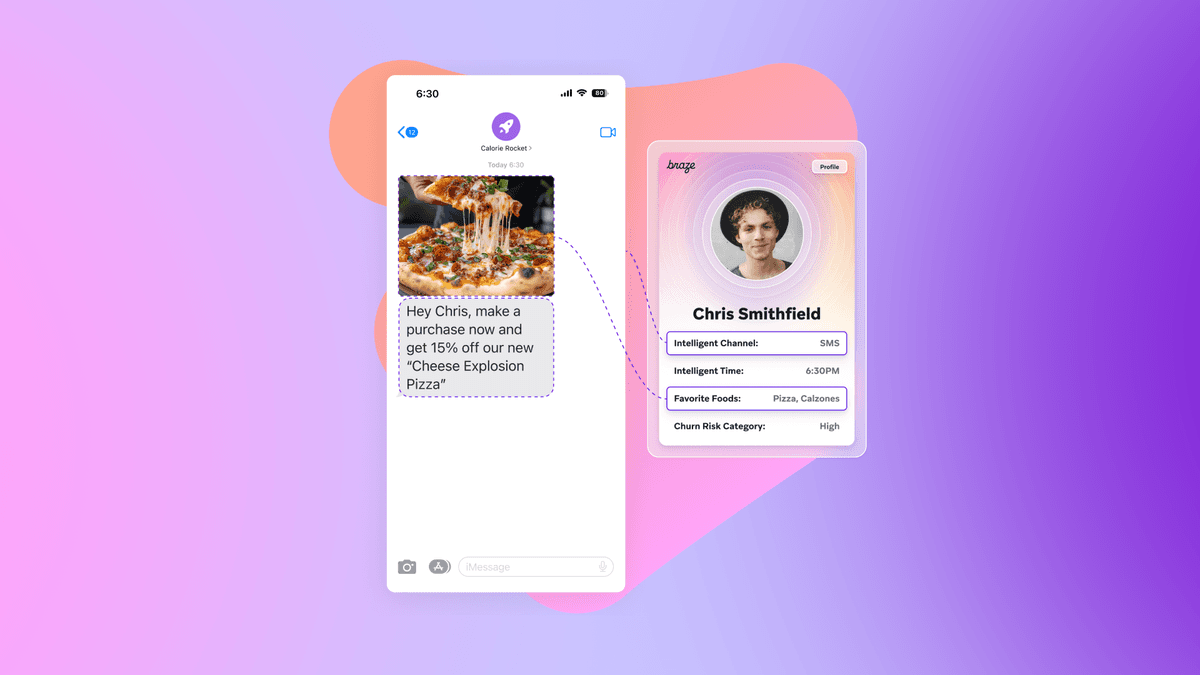

Team Braze
The most effective customer experiences feel effortless—like they were made just for you. That’s the promise of dynamic personalization: Customization that adapts to each person’s needs, preferences, and behaviors.
Unlike static personalization, dynamic personalization goes further. It updates and evolves, shaping everything from websites and product recommendations to mobile messages and cross-channel journeys.
In this guide, we’ll explore what dynamic personalization really means, how it works across touchpoints, and what it takes to do it well.
Contents
- What is dynamic personalization
- Why dynamic personalization matters across the customer experience
- Key benefits of dynamic personalization
- Personalization tactics that evolve with behavior and context
- How to get started with dynamic personalization
- Choosing the right tools for dynamic personalization
- Final thoughts on dynamic personalization
- FAQs about dynamic personalization
What is dynamic personalization?
Dynamic personalization refers to the practice of tailoring content, messages, and experiences to each customer based on individual user data and behavior. Unlike static personalization—where content is customized once, based on broad segments—dynamic personalization continuously updates as new data comes in.
This approach allows brands to tailor what a person receives in the moment: Whether that’s a product recommendation, a message within a mobile app, or an offer in an email. It’s powered by real-time data, flexible content logic, and systems that can act across channels, and can entirely change and improve the way customers interact with your brand.
Why dynamic personalization matters across the customer experience
Dynamic personalization helps transforms the customer journey. From the first time someone visits your website to the moment they complete a purchase (and beyond), personalization that adapts can dramatically improve how people experience your brand.
This approach goes far beyond traditional website personalization. It can shape:
- Web pages that change based on referral source, browsing behavior, or location
- App content that updates with in-session activity
- Emails or push notifications with the recommendations that will most likely lead to a conversion
- Messaging flows that shift based on evolving user preferences or lifecycle stage
By tailoring each interaction, dynamic personalization helps brands deliver experiences that feel intuitive—not intrusive.
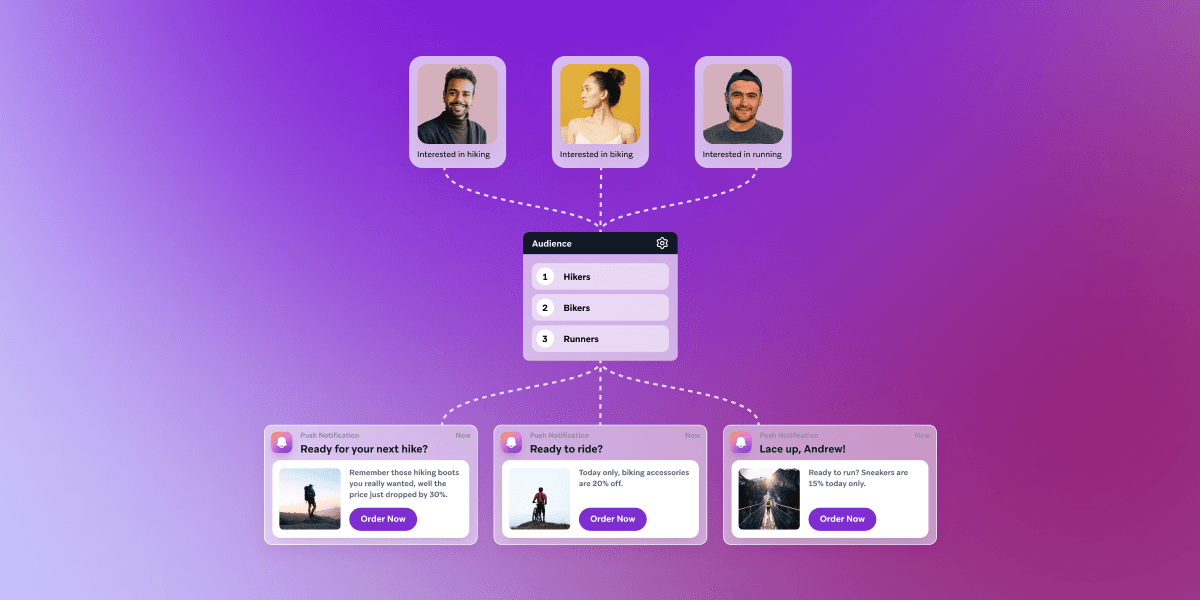
Key benefits of dynamic personalization
Personalized website experiences help visitors find what they need faster—and stick around longer. When your content adapts, the journey feels more valuable and seamless. That kind of relevance drives results. Braze research has found that using marketing automation tools like Connected Content to support dynamic message personalization results in a 1.3X uplift in conversions.
Personalization also builds stronger relationships over time. When people feel understood, they’re more likely to come back, leading to greater loyalty and higher customer lifetime value.
Here’s what dynamic personalization can do for your brand:
Higher conversion rates
By tailoring offers, content, and timing to each user’s behavior and intent, you make it easier for them to say yes. Personalized landing pages, product suggestions, or abandoned cart messages all drive stronger action.
Deeper customer relationships
When people feel understood, they’re more likely to stick around. Dynamic personalization builds trust by showing that your brand recognizes and responds to individual needs in real time.
Increased engagement and retention
Relevant, timely experiences keep customers coming back. Whether it’s a triggered push notification at the perfect moment or content that adapts to a customer’s preferences, personalization can boost session duration, email opens, and app usage.
Smarter use of marketing resources
Dynamic personalization helps teams act on the data they already have—automating manual segmentation, reducing message fatigue, and making campaigns more efficient.
More value from cross-channel orchestration
When personalization connects across touchpoints—like web, mobile, email, and in-product messaging—it creates a consistent, intelligent journey that’s far more powerful than siloed interactions.
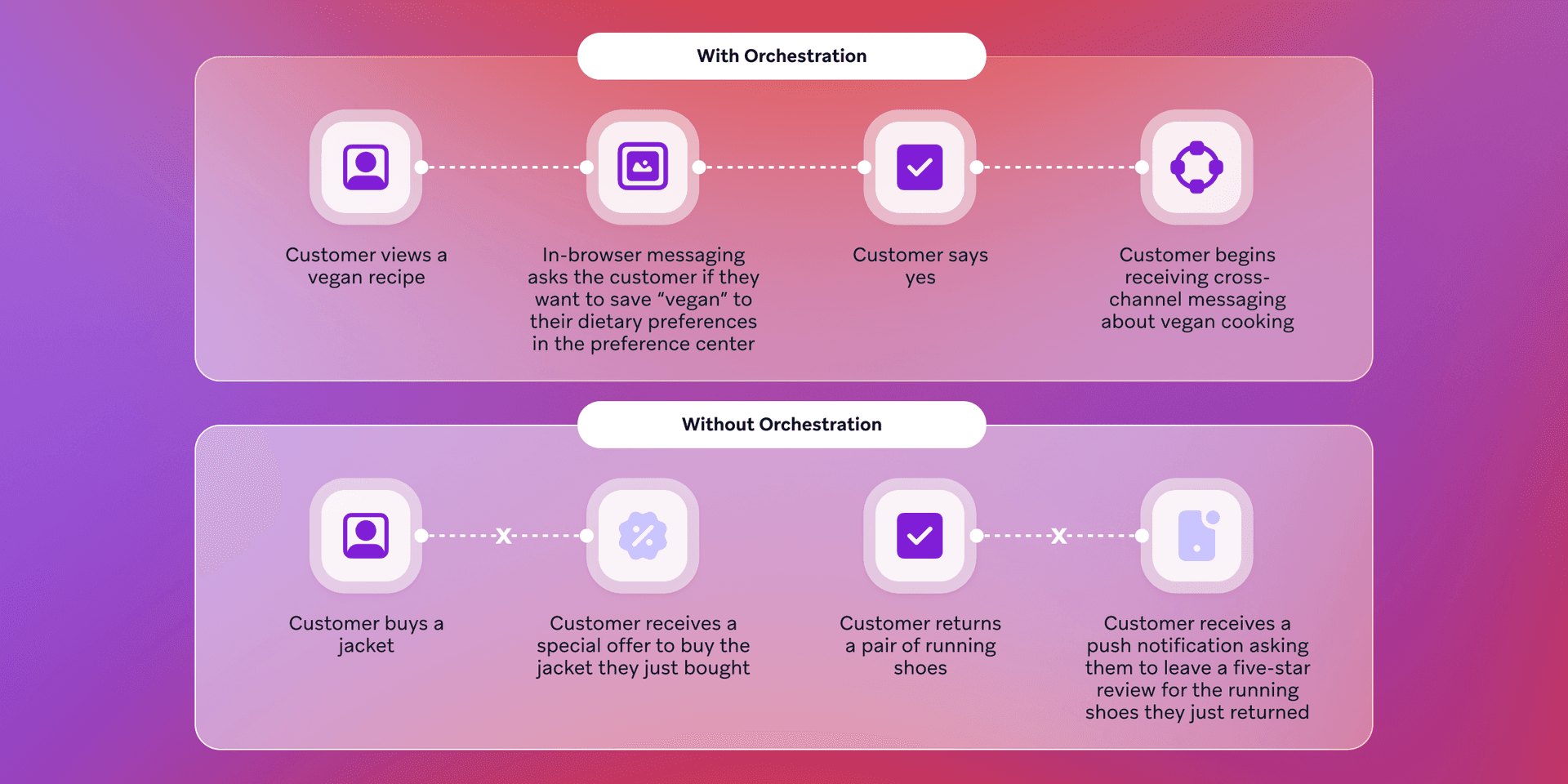
Personalization tactics that evolve with behavior and context
The best dynamic personalization strategies adapt in real time, drawing on behavior, preferences, and context to guide what a customer sees, hears, or receives. Below are some key personalization tactics—each grounded in dynamic, data-driven decisioning.
On-site dynamic content personalization
To benefit from dynamic content personalization, swap images, recommendations, or CTAs based on referral source, past browsing, or product affinity. For example, a first-time visitor might see social proof, while a returning customer sees an exclusive offer.
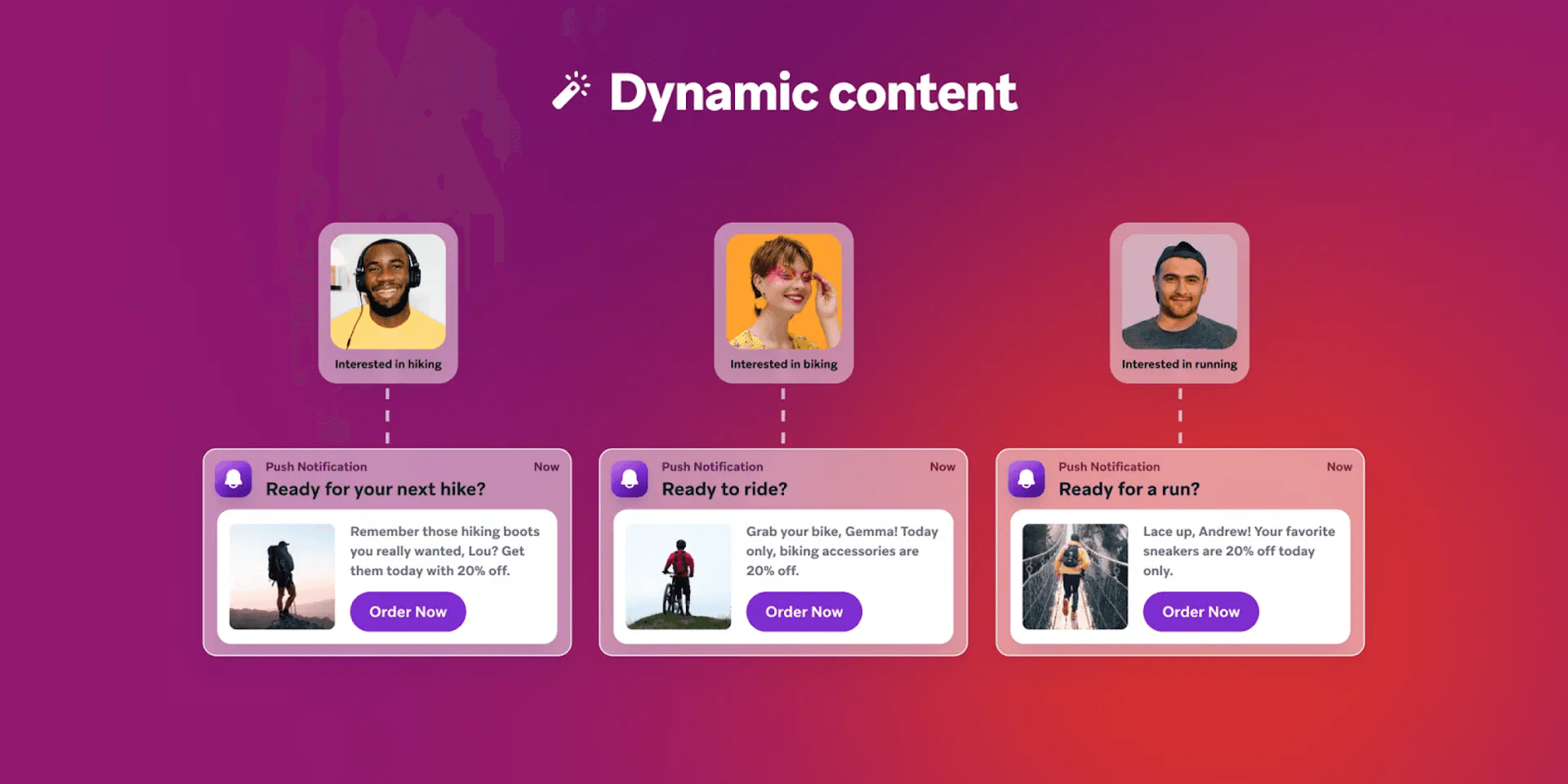
Mobile outreach
Send targeted push or in-app messages based on user actions, location, or lifecycle stage. Like a reminder after cart abandonment or a welcome offer that appears after someone finishes onboarding.
Messages that adapt on the fly
Adjust message content based on real-time behaviors—such as email opens, recent clicks, or app activity. Dynamic blocks can update product recommendations or reflect stock changes even after send time.
Behavioral journey-based messaging
Build messaging flows that shift as a customer moves through their lifecycle. Someone who browses without converting might enter a nurturing track, while a loyal customer could receive VIP treatment.
Tailored content hubs and experiences
Use dynamic personalization to shape an entire content experience—highlighting articles, videos, or offers based on interest signals or account type.
B2B-specific dynamic personalization
Personalize landing pages based on company size, industry, or stage in the buying cycle. Use ABM strategies to dynamically serve relevant case studies or CTAs per account.
How to get started with dynamic personalization
You don’t need to overhaul your entire tech stack to start using dynamic personalization. The key is to start where you are—using the data and tools you already have—and build from there. Here’s a practical framework to guide your approach:
1. Define your goals
Are you trying to improve conversions, reduce churn, increase engagement, or all of the above? Start with clear objectives so you can measure what matters.
2. Identify key touchpoints
Map out where personalization could make the biggest difference—think landing pages, app onboarding, email campaigns, cart recovery, or post-purchase flows.
3. Segment based on actionable data
Use zero-party data (shared directly by users), first-party dataa (like clicks and purchases), and other contextual signals (such as location or device type) to inform your personalization logic.
4. Choose the right content or message logic
What should change based on user behavior? Headlines, recommendations, message timing? Create flexible templates and logic that let you swap in dynamic elements easily.
5. Start small and experiment
Test one or two personalized experiences. Measure impact, iterate, and scale at your own pace. Success often starts with one high-impact use case that proves the value.
6. Measure and refine
Track key metrics like conversion rate, click-through rate, retention, and ROI. Use those insights to refine your personalization strategy and expand into new channels or customer journeys.
Dynamic personalization is a process, not a one-time setup. The more your strategy evolves alongside your audience, the more value you’ll unlock.
Choosing the right tools for dynamic personalization
To deliver meaningful, real-time personalization experiences across channels, you need tools that are flexible, responsive, and built for scale. Here’s what to look for:
Real-time data processing
The ability to act on data as it’s received—whether that’s a cart abandonment event, a location signal, or a behavior trigger—is important for personalization that feels timely and relevant.
Cross-channel execution
Look for tools that support website personalization, email, mobile messaging, in-app experiences, and more—all from one platform. A consistent experience across touchpoints builds trust and impact.
Dynamic content and message templates
You’ll need the ability to swap in different content blocks, product recommendations, or offers based on user profiles or behaviors. Flexible templates speed up testing and rollout.
Behavioral segmentation and triggers
Choose a solution that lets you segment audiences based on real-time actions, not just static attributes. Bonus if it includes predictive capabilities to anticipate customer needs.
Orchestration and journey mapping
A strong personalization engine should integrate seamlessly with journey orchestration tools, allowing you to build adaptive flows that evolve based on customer behavior.
Integration with your broader stack
The right tool should play well with your CRM, CDP, analytics platform, and data warehouse—so you can centralize insight and deliver personalization wherever it matters.
Final thoughts on dynamic personalization
Customers don’t think in channels—they just want relevant, seamless experiences that make sense in the moment. Dynamic personalization helps brands meet that expectation by adapting content, messaging, and journeys based on behaviors, preferences, and more.
Whether you’re updating a homepage, triggering a push notification, or shaping an entire cross-channel flow, dynamic personalization turns static interactions into living, responsive experiences. And when powered by the right tools and data, it’s a strategy that scales—delivering stronger engagement, better retention, and real business impact.
FAQs about dynamic personalization
Dynamic personalization refers to the practice of tailoring content, messages, and experiences in real-time based on individual user data and behavior. Unlike static personalization, which involves pre-defined segments or templates, dynamic personalization adapts to each user's unique preferences, interactions, and context at the moment they engage with a brand.
The primary difference between dynamic and static personalization lies in how content and experiences are tailored to users based on their data and behavior.
Dynamic personalization:
- Real-time adaptation: Dynamic personalization adjusts content and messaging in real-time based on individual user behavior, preferences, and context. This means that as users interact with a brand, the experience can change instantly to reflect their current interests or actions.
- Data-driven: It relies heavily on real-time data analytics, utilizing information such as browsing history, purchase behavior, location, and demographic details to deliver highly relevant and personalized experiences.
- Behavioral targeting: Dynamic personalization can respond to user actions, such as clicks or page views, allowing brands to present tailored recommendations or offers that align with what the user is currently interested in.
- Automation: This approach often involves automated systems that can deliver personalized content across multiple channels (e.g., email, website, mobile app) without manual intervention, ensuring timely and relevant communication.
Static personalization:
- Pre-defined segments: Static personalization involves creating content and experiences based on predefined segments or templates. Users are categorized into groups based on fixed attributes (e.g., demographics, past purchases) and receive the same content as others in that segment.
- Limited adaptability: Once set, static personalization does not change in response to real-time user behavior. For example, a user might receive a generic email based on their demographic profile, regardless of their recent interactions with the brand.
- Less granular: Static personalization tends to be less granular and may not fully capture the nuances of individual user preferences, leading to a one-size-fits-all approach that may not resonate with every user.
- Manual updates: Adjustments to static personalization often require manual updates to the content or segments, making it less agile compared to dynamic personalization.
In essence, dynamic personalization offers a more tailored and responsive approach to customer engagement, leveraging real-time data to create individualized experiences, while static personalization relies on fixed segments and pre-defined content, resulting in a less personalized interaction. Dynamic personalization is generally more effective in enhancing customer satisfaction and driving engagement, as it aligns more closely with individual user needs and behaviors.
By tailoring experiences to what users want or need in the moment, dynamic personalization increases relevance—making people more likely to engage or convert. Dynamic personalization can significantly improve conversion rates through several key mechanisms:
- Relevance: By delivering content and offers that are tailored to individual user preferences and behaviors, dynamic personalization ensures that users see what is most relevant to them. This relevance increases the likelihood of engagement and conversion, as users are more inclined to act on offers that resonate with their interests.
- Address needs in-the-moment: Dynamic personalization allows brands to respond to user actions in real-time. For example, if a user abandons a shopping cart, a personalized follow-up email can be triggered to remind them of the items left behind, potentially including a discount. This timely intervention can encourage users to complete their purchases.
- Enhanced user experience: Personalized experiences create a more enjoyable and seamless interaction for users. When users feel understood and valued, they are more likely to trust the brand and engage further, leading to higher conversion rates. A positive user experience can also foster brand loyalty, encouraging repeat purchases.
- Increased engagement: Personalized content tends to capture users' attention more effectively than generic messaging. Higher engagement levels can lead to more interactions, such as clicks, shares, and ultimately conversions, as users are more likely to respond to content that feels tailored to them.
By understanding and responding to individual user needs, brands can create more effective marketing strategies that drive sales and foster customer loyalty.
A dynamic email might include personalized product suggestions based on browsing behavior or a location-based offer, that is automatically tailored to each customer who receives it.
Personalization platforms like Braze support dynamic content, behavioral triggers, and journey orchestration across email, mobile, web, and in-app channels.
Yes. Dynamic personalization can be applied to websites, emails, push notifications, SMS, and in-app experiences—creating cohesive, personalized journeys.
Related Tags
Be Absolutely Engaging.™
Sign up for regular updates from Braze.
Related Content
View the Blog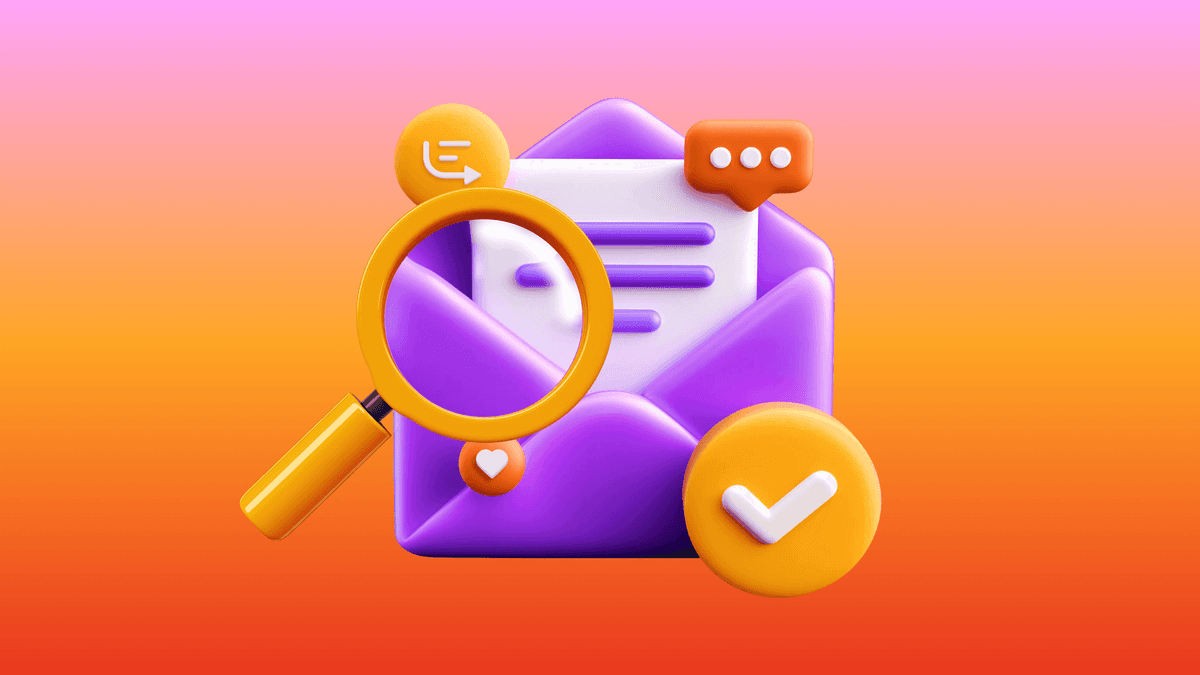
The new inbox reality: How iOS changes are reshaping email marketing

Aparna Prasad

Experience optimization: Turning data insights into better journeys

Team Braze

December 2025 Bonfire Marketer of the Month: Jagex’s Emma Oliver
